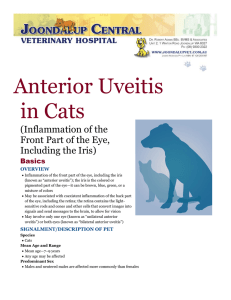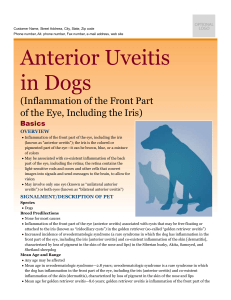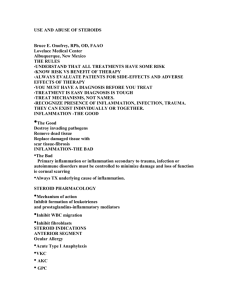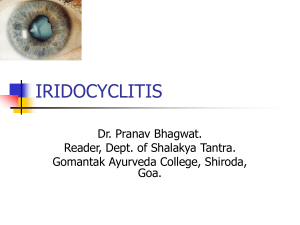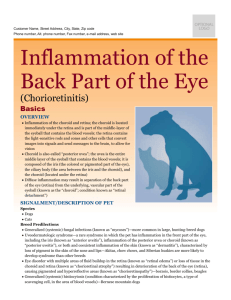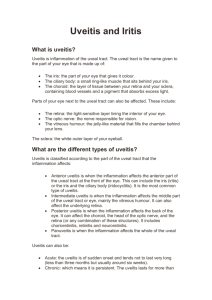anterior_uveitis_in_cats
advertisement
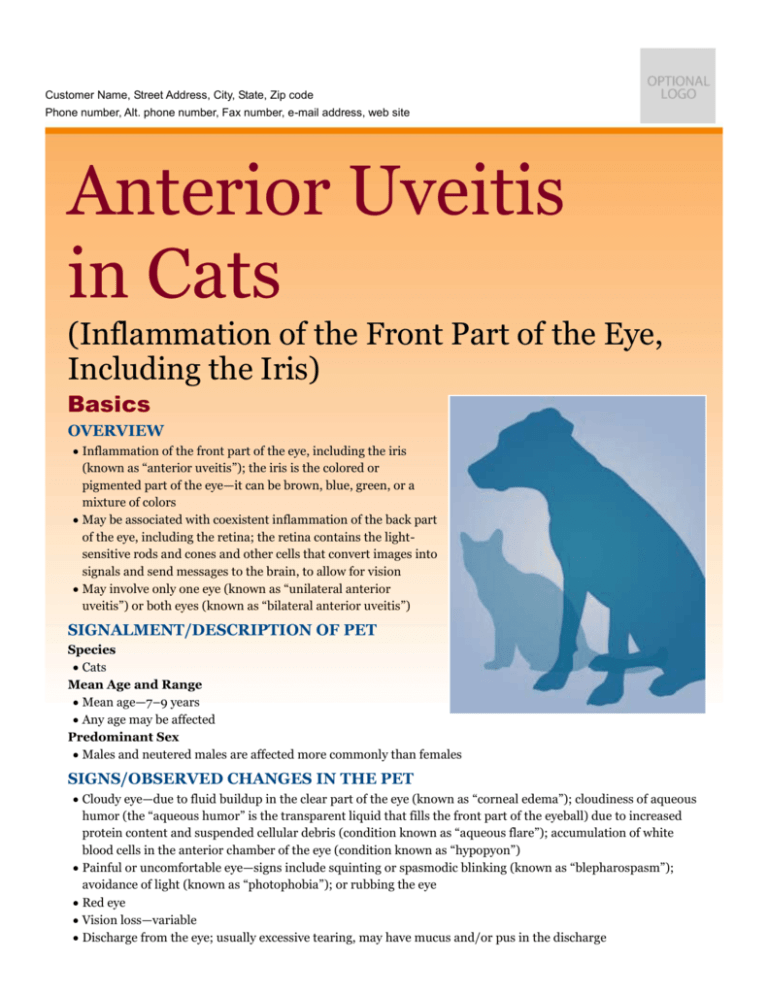
Customer Name, Street Address, City, State, Zip code Phone number, Alt. phone number, Fax number, e-mail address, web site Anterior Uveitis in Cats (Inflammation of the Front Part of the Eye, Including the Iris) Basics OVERVIEW • Inflammation of the front part of the eye, including the iris (known as “anterior uveitis”); the iris is the colored or pigmented part of the eye—it can be brown, blue, green, or a mixture of colors • May be associated with coexistent inflammation of the back part of the eye, including the retina; the retina contains the lightsensitive rods and cones and other cells that convert images into signals and send messages to the brain, to allow for vision • May involve only one eye (known as “unilateral anterior uveitis”) or both eyes (known as “bilateral anterior uveitis”) SIGNALMENT/DESCRIPTION OF PET Species • Cats Mean Age and Range • Mean age—7–9 years • Any age may be affected Predominant Sex • Males and neutered males are affected more commonly than females SIGNS/OBSERVED CHANGES IN THE PET • Cloudy eye—due to fluid buildup in the clear part of the eye (known as “corneal edema”); cloudiness of aqueous humor (the “aqueous humor” is the transparent liquid that fills the front part of the eyeball) due to increased protein content and suspended cellular debris (condition known as “aqueous flare”); accumulation of white blood cells in the anterior chamber of the eye (condition known as “hypopyon”) • Painful or uncomfortable eye—signs include squinting or spasmodic blinking (known as “blepharospasm”); avoidance of light (known as “photophobia”); or rubbing the eye • Red eye • Vision loss—variable • Discharge from the eye; usually excessive tearing, may have mucus and/or pus in the discharge • Keratic precipitates—aggregates of inflammatory cells adhering to various areas of the inner lining of the cornea (known as “corneal endothelium”); the cornea is the clear outer layer of the front of the eye • Development of blood vessels in the clear part of the eye (known as “corneal vascularization”) • Small or constricted pupil, frequently resistant to medical treatment to dilate the pupil • Swelling of the iris • Decreased pressure within the eye (known as “intraocular pressure” [IOP]) is consistent with anterior uveitis, but is not seen in all cases • Scar tissue between the iris and the lens of the eye (known as “posterior synechia”); the lens is the normally clear structure directly behind the iris that focuses light as it moves toward the back part of the eye (retina) • Accumulations of white blood cells (hypopyon), red blood cells (known as “hyphema”), or fibrin in the anterior chamber of the eye • Long-term (chronic) changes may include color variation of the iris; development of cataracts (opacity in the normally clear lens, preventing passage of light to the back part of the eye [retina]); movement of the lens out of its normal location (known as “lens luxation”); secondary glaucoma (in which the pressure within the eye [intraocular pressure] is increased secondary to inflammation in the front part of the eye); and softening and loss of tissue of the eyeball (known as “phthisis bulbi”) CAUSES • Infectious—fungal or mycotic infections (such as Blastomyces, Cryptococcus neoformans, Coccidiodes immitis, Histoplasma capsulatum); protozoal infection (Toxoplasma gondii); bacterial infection (such as Bartonella, Mycobacterium, any generalized disease caused by the spread of bacteria in the blood [known as “septicemia” or “blood poisoning”]); viral infection (such as feline immunodeficiency virus [FIV}, feline leukemia virus [FeLV], feline coronavirus, feline herpesvirus-1 [FHV-1]); parasitic infection (due to invasion of parasitic larvae into the tissues of the eye) • Unknown cause (so-called “idiopathic disease”)—lymphocytic-plasmacytic uveitis; inflammation of the front part of the eye (including the iris) characterized by the presence of lymphocytes and plasma cells; lymphocytes are a type of white blood cell that are formed in lymphatic tissues throughout the body; lymphocytes are involved in the immune process; plasma cells or plasmacytes are a specialized type of white blood cell; plasma cells are lymphocytes that have been altered to produce immunoglobulin, an immune protein or antibody necessary for fighting disease • Immune-mediated reaction to lens proteins (due to cataract or lens trauma) • Cancer—primary tumors of the eye (such as diffuse iris melanoma, ocular sarcoma); secondary tumors (such as lymphoma) due to the spread of the cancer (metastasis) • Metabolic—increased levels of lipids (compounds that contain fats or oils) in the blood (known as “hyperlipidemia”); increased protein in the blood leading to sludging of the blood (known as “hyperviscosity”); generalized (systemic) high blood pressure (hypertension) • Miscellaneous—trauma; disorder of the cornea (the clear outer layer of the front of the eye) characterized by the presence of ulcers, with or without inflammation (condition known as “ulcerative keratitis”); abscess involving the cornea (known as a “corneal stromal abscess”); presence of poisons or toxins in the blood (known as “toxemia”) of any cause RISK FACTORS • None specific • Suppression of the ability to develop a normal immune response (known as “immune suppression”) and geographic location may increase incidence of certain infectious causes of inflammation of the front part of the eye, including the iris (anterior uveitis) Treatment HEALTH CARE • Outpatient medical management generally sufficient ACTIVITY • No changes indicated in most cases • Reduced exposure to bright light may alleviate discomfort DIET • No changes indicated SURGERY • None in most cases • Specific instances requiring surgical intervention include removal of ruptured lenses and surgical management of secondary glaucoma (in which the pressure within the eye [intraocular pressure] is increased secondary to inflammation in the front part of the eye) • Long-term (chronic) inflammation of the front part of the eye, including the iris (anterior uveitis) leading to secondary glaucoma commonly necessitates surgical removal (known as “enucleation”) of the affected eyeball(s) • Surgical removal (enucleation) of the eyeball is recommended in cats with inflammation of the front part of the eye, including the iris (anterior uveitis), related to cancer of the iris (diffuse iris melanoma) or other primary tumors within the eye Medications Medications presented in this section are intended to provide general information about possible treatment. The treatment for a particular condition may evolve as medical advances are made; therefore, the medications should not be considered as all inclusive STEROIDS • Topical steroids are medications that are applied directly to the eye, such as prednisolone acetate 1% and dexamethasone 0.1%; other topical steroids (such as betamethasone, hydrocortisone) are less effective in the treatment of inflammation within the eye—stopping topical steroids abruptly may result in rebound of inflammation of the eye • Subconjunctival steroids are medications that are administered by injection into the moist tissues surrounding the eye (known as the “conjunctiva”), such as triamcinolone acetonide and methylprednisolone; often not required; may be used in severe cases, followed by topical and/or systemic anti-inflammatory drugs • Systemic steroids are medications that are administered by injection or by mouth (orally), such as prednisone; should only be used if generalized (systemic) infections have been eliminated as possible cause of the inflammation of the front of the eye, including the iris (anterior uveitis) NONSTEROIDAL ANTI-INFLAMMATORY DRUGS • Topical nonsteroidal anti-inflammatory drugs (NSAIDs) are medications applied directly to the eye, such as flurbiprofen and diclofenac • Systemic NSAIDs are medications administered by injection or by mouth (orally); an example is aspirin (aspirin should not be administered at the same time as systemic steroids and should be avoided if blood is present in the front of the eye [hyphema]) • Meloxicam—may be administered into a vein (known as “intravascular” or IV administration), by injection under the skin (known as “subcutaneous” or SQ injection), or by mouth (known as “oral administration”) TOPICAL MYDRIATIC/CYCLOPLEGIC MEDICATION (TO DILATE THE PUPIL AND TO DECREASE PAIN IN THE EYE) • Atropine sulfate 1%—applied directly to the eye to dilate the pupil and to decrease pain in the eye; atropine is very bitter and if cat gets medication in its mouth, excessive drooling will be seen; ointment is preferred over solution in cats, as it causes less drooling Follow-Up Care PATIENT MONITORING • Recheck in 3–7 days, depending on severity of disease • Pressure within the eye (intraocular pressure or IOP) should be monitored at recheck to detect secondary glaucoma (in which the pressure within the eye is increased secondary to inflammation in the front part of the eye) • Frequency of subsequent rechecks dictated by severity of disease and response to treatment POSSIBLE COMPLICATIONS • Generalized (systemic) complications occur as a result of the systemic cause of the inflammation of the front of the eye, including the iris (anterior uveitis) • Complications involving the eye include secondary glaucoma (in which the pressure within the eye [intraocular pressure or IOP] is increased secondary to inflammation in the front part of the eye)—common complication of long-term (chronic) uveitis in cats; secondary cataract (opacity in the normally clear lens, preventing passage of light to the back part of the eye [retina]) development; movement of the lens out of its normal location (lens luxation); retinal detachment; and softening and loss of tissue of the eyeball (phthisis bulbi) EXPECTED COURSE AND PROGNOSIS • Guarded prognosis for affected eye(s) • Depends on underlying disease and response to treatment • Cats with treatable underlying disease (such as toxoplasmosis) are more likely to have favorable outcome for the eye than those with idiopathic lymphocytic-plasmacytic uveitis or untreatable underlying condition (such as feline infectious peritonitis [FIP], feline immunodeficiency virus [FIV]); “idiopathic lymphocytic-plasmacytic uveitis” is a condition of unknown cause characterized by the presence of lymphocytes and plasma cells in the front part of the eye (uveitis); lymphocytes are a type of white blood cell that are formed in lymphatic tissues throughout the body; lymphocytes are involved in the immune process; plasma cells or plasmacytes are a specialized type of white blood cell; plasma cells are lymphocytes that have been altered to produce immunoglobulin, an immune protein or antibody necessary for fighting disease Key Points • Potential of generalized (systemic) diseases causing signs of inflammation of the front part of the eye, including the iris (anterior uveitis); therefore, appropriate diagnostic testing is important • In addition to symptomatic treatment of inflammation of the front part of the eye, including the iris (anterior uveitis), treatment of underlying disease (when possible) is paramount to a positive outcome • Compliance with treatment and follow-up recommendations may reduce the likelihood of complications Enter notes here Blackwell's Five-Minute Veterinary Consult: Canine and Feline, Fifth Edition, Larry P. Tilley and Francis W.K. Smith, Jr. © 2011 John Wiley & Sons, Inc.
